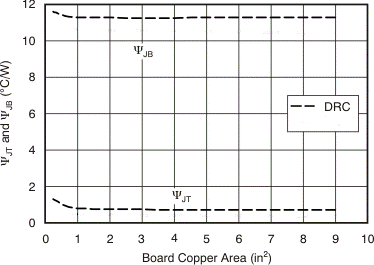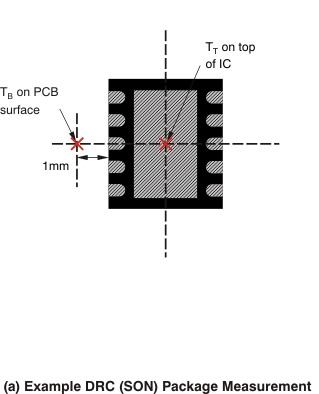JAJSKZ8D April 2010 – December 2023 TPS74701-Q1
PRODUCTION DATA
- 1
- 1 特長
- 2 アプリケーション
- 3 概要
- 4 Pin Configuration and Functions
- 5 Specifications
- 6 Detailed Description
- 7 Application and Implementation
- 8 Device and Documentation Support
- 9 Revision History
- 10Mechanical, Packaging, and Orderable Information
パッケージ・オプション
メカニカル・データ(パッケージ|ピン)
- DRC|10
サーマルパッド・メカニカル・データ
- DRC|10
発注情報
7.4.1.2 Estimating Junction Temperature
Using the thermal metrics ΨJT and ΨJB, as shown in the Thermal Information table, the junction temperature can be estimated with corresponding formulas (given in Equation 7). For backwards compatibility, an older RθJC,Top parameter is listed as well.

Where PD is the power dissipation shown by Equation 7, TT is the temperature at the center-top of the device package, and TB is the PCB temperature measured 1 mm away from the device package on the PCB surface (see Figure 7-7).
Both TT and TB can be measured on actual application boards using a thermo-gun (an infrared thermometer).
For more information about measuring TT and TB, see the Using New Thermal Metrics application note, available for download at www.ti.com.
In reference to Figure 7-6, the new thermal metrics (ΨJT and ΨJB) have very little dependency on board size. That is, using ΨJT or ΨJB with Equation 7 is a good way to estimate TJ by simply measuring TT or TB, regardless of the application board size.
 Figure 7-6 ΨJT and ΨJB vs Board
Size
Figure 7-6 ΨJT and ΨJB vs Board
SizeFor a more detailed discussion of why TI does not recommend using RθJC(top) to determine thermal characteristics, see the Using New Thermal Metrics application note, available for download at www.ti.com. For further information, see the Semiconductor and IC Package Thermal Metrics application note, also available on the TI website.
